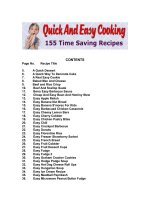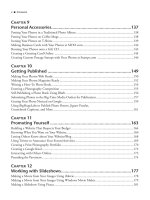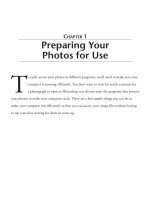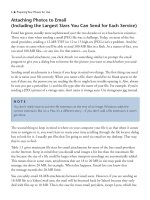Quick and easy learning games phonics
Bạn đang xem bản rút gọn của tài liệu. Xem và tải ngay bản đầy đủ của tài liệu tại đây (949.68 KB, 48 trang )
Quick-and-Easy Learning Games
Phonics
by Wiley Blevins
S
C
H
O
L
A
S
T
I
C
PROFESSIONALBOOKS
New York • Toronto • London • Auckland • Sydney
Quick-and-Easy Learning Games: Phonics © Scholastic Teaching Resources
Dedication
I would like to dedicate this book to my former students, whose zest for learning,
innocence, and endless laughter have given me so much personal and professional
satisfaction. I would also like to dedicate this book to my grandmother, who never
had the opportunity to learn to read. It is because of her that I became a teacher.
Acknowledgments
I would like to thank Jeanne Chall, Marilyn Jager Adams, M.E. Curtis, and the many other professors,
colleagues, and classroom teachers who have taught me so much about how children learn to read.
Scholastic grants teachers permission to photocopy the games for classroom use. No other part of this publication may
be reproduced in whole or in part, or stored in a retrieval system, or transmitted in any form or by any means, electronic, mechanical, photocopying, recording, or otherwise, without permission of the publisher. For information
regarding permission, write to Scholastic Professional Books, 555 Broadway, New York, NY 10012-3999.
Editor: Joan Novelli
Cover design by Jaime Lucero and Vincent Ceci
Cover and interior illustration by Paige Billin-Frye
Interior design by Sydney Wright
ISBN 0-590-96380-5
Copyright © 1996 by Scholastic Inc. All rights reserved. Printed in the U.S.A.
12 11 10 9 8 7 6 5 4 3 2 1
6 7 8 9/9/01/0
Quick-and-Easy Learning Games: Phonics © Scholastic Teaching Resources
Contents
The Role of Phonics in a Balanced Reading Program . . . . . . . . . . . . . . . . . . . . . . . . .4
About this Book . . . . . . . . . . . . . . . . . . . . . . . . . . . . . . . . . . . . . . . . . . . . . . . . . . . . . . .6
Go to School . . . . . . . . . . . . . . . . . . . . . . . . . . . . . . . . . . . . . . . . . . . . . . . . . . . . . . . . . .9
Children race to school in this consonants game.
Spin It! . . . . . . . . . . . . . . . . . . . . . . . . . . . . . . . . . . . . . . . . . . . . . . . . . . . . . . . . . . . . . .13
Letters replace numbers in this spinner game that reinforces short vowels and
word building.
Frog Hop . . . . . . . . . . . . . . . . . . . . . . . . . . . . . . . . . . . . . . . . . . . . . . . . . . . . . . . . . . . .16
Players hop around the board, using picture clues to guess which short vowels they need
to complete words.
Build a House . . . . . . . . . . . . . . . . . . . . . . . . . . . . . . . . . . . . . . . . . . . . . . . . . . . . . . . .21
Players construct houses, word by word, by combining phonograms with consonants
and blends.
Vowel Checkers . . . . . . . . . . . . . . . . . . . . . . . . . . . . . . . . . . . . . . . . . . . . . . . . . . . . . .26
Jumping from one square to another, players read long vowel words to capture
opponents’ pieces and get to the other side.
Sound Bingo . . . . . . . . . . . . . . . . . . . . . . . . . . . . . . . . . . . . . . . . . . . . . . . . . . . . . . . . .28
Rain, chain, train . . . this game of bingo helps children build long vowel skills.
Raceway . . . . . . . . . . . . . . . . . . . . . . . . . . . . . . . . . . . . . . . . . . . . . . . . . . . . . . . . . . . .30
Players pick up vowel spellings from flags along a racetrack to build new words;
familiar Shoots and Ladders–like shortcuts add to the fun.
Build-a-Word . . . . . . . . . . . . . . . . . . . . . . . . . . . . . . . . . . . . . . . . . . . . . . . . . . . . . . . . .33
Using letters and word parts on cards, players try to form as many words from the
parts as they can before they run out of time.
Blend TIC-TAC-TOE . . . . . . . . . . . . . . . . . . . . . . . . . . . . . . . . . . . . . . . . . . . . . . . . . . . .36
Children put blends and word endings together to turn a deck of cards into words.
Match It! . . . . . . . . . . . . . . . . . . . . . . . . . . . . . . . . . . . . . . . . . . . . . . . . . . . . . . . . . . . .40
Players put beginnings and endings together to make words.
Roll, Pick, and Read . . . . . . . . . . . . . . . . . . . . . . . . . . . . . . . . . . . . . . . . . . . . . . . . . . .42
Players roll a die, take the number of cards indicated, then try to make as many words
from the parts as they can.
Vowel Concentration . . . . . . . . . . . . . . . . . . . . . . . . . . . . . . . . . . . . . . . . . . . . . . . . . .44
Book, look . . . rhyming words make matches in this familiar game.
Back to the Barn . . . . . . . . . . . . . . . . . . . . . . . . . . . . . . . . . . . . . . . . . . . . . . . . . . . . . .46
R-controlled vowels like bird and burn lead the way to the barn in this board game.
3
Quick-and-Easy Learning Games: Phonics © Scholastic Teaching Resources
The Role of Phonics in
a Balanced Reading Program
R
ecently, because of declines in reading test scores and concerns about
the lack of skills instruction in schools, there has been a renewed interest in
phonics instruction. I believe that the teaching of phonics in a meaningful
context is an important element in a balanced reading program—one that
addresses the developmental needs of children based on the stage of reading
they are at.
To understand how best to meet the needs of beginning readers, here is an
overview of the early stages of reading development. During these stages,
children learn sound/spelling correspondences and the principles of blending.
According to Juel (1991), these stages include:
1. Selective-cue stage: During this stage, readers pay more attention to contextual cues, such as context and picture clues. Stories that contain repetitive
text structures or rhyming patterns are common reading during this stage and
help children to predict words while reading.
2. Spelling-sound stage: During this stage, readers focus on graphophonic
cues. It is during this stage that phonics instruction plays a crucial role as children are attending to each letter in words.
3. Automatic stage: During this stage, readers utilize both contextual (meaning) and graphophonic (phonics) cues. It is during this stage that readers
develop fluency.
4
Quick-and-Easy Learning Games: Phonics © Scholastic Teaching Resources
When I think about these stages, I ask myself, What do children need instructionally to effectively progress through each?
Reading programs that focus only on the selective-cue stage are referred to
as meaning-oriented programs. Although most of these programs do contain
some phonics instruction, there are few opportunities for children to practice
their phonics skills with connected text. Therefore, children tend to undervalue the utility of the phonics skills they are learning. Connected texts should
contain a large portion of words that can be decoded based on the sounds
children have been taught up to that point. Although most practice stories in
these programs do contain words that begin with a target sound taught, the
words aren’t decodable based on the sounds children have been previously
taught. Therefore, these children are forced to rely on meaning cues, losing
out on important blending practice.
Programs that focus only on phonics are referred to as phonics-oriented programs. Phonics instruction void of a print-rich environment with multiple language experiences can be dull and can leave children unaware that reading
is more than just sounding out words, it is also making meaning from text.
A balanced approach to reading instruction emphasizes both contextual
(meaning) and graphophonic (phonics) cues, and provides reading support
materials so children have multiple opportunities to practice these cueing systems. Phonics is only one important element of this reading instruction. In
the context of great literature and varied language experiences, children can
and will learn to read with the aid of a strong phonics program, attention to
prerequisite skills such as phonemic awareness and alphabet recognition, and
the skill of a caring teacher. Teaching children to read and instilling in them a
love for reading is one of the best gifts any teacher can give.
Much success,
Wiley Blevins
5
Quick-and-Easy Learning Games: Phonics © Scholastic Teaching Resources
About this Book
The best way for children to apply their phonics skills is through reading simple, engaging stories that contain a large portion of words that can be blended based on the sounds
learned. In addition to the reading of easy text, learning games are an enjoyable way for
children to practice and reinforce their phonics skills. Games are especially useful as
learning tools for children who have had difficulty with more traditional learning
approaches.
Quick-and-Easy Learning Games: Phonics focuses on children’s knowledge of
sound/spelling correspondences and their ability to blend words. Some of the benefits of
integrating these games into your reading program follow.
• Phonics games provide children with a way to assess their own phonics abilities
through the immediate feedback they receive while playing.
• Watching children play phonics games serves as a valuable assessment tool for you,
letting you pick up on strengths and areas of need as children interact in a relaxed
atmosphere.
• On a social level, game playing can help children learn to work cooperatively, give
and take praise and criticism, teach others, and accept successes and failures.
The games in Quick-and-Easy Learning Games: Phonics have been sequenced, using a
scope and sequence followed by many early reading programs. However, most of the
games can be adapted to review phonics skills other than those designated.
Preparing to Play
Each of the 13 games includes the game boards and cards your students need to play, plus
spinners and dice as necessary. To support your instructional goals, each game also comes
with a page of teaching materials that includes:
• Players: the recommended number of players in each game group
• Skill: the phonics focus in the particular game
• To Play: step-by-step directions to share with students
• Variations: suggestions for making the game easier, more challenging, and so on
6
Quick-and-Easy Learning Games: Phonics © Scholastic Teaching Resources
Most of the games in the book can be put together in well under an hour; in fact, some can
be duplicated and made ready for play in minutes. The following suggestions will help
you adapt the games for your class:
1. Enlarge game boards, game cards, and other game pieces on a photocopier, if desired.
2. Paste game boards onto larger pieces of colored construction paper before decorating
and laminating. (When game boards are on two pages, tape the halves together.)
3. Transfer word and word building cards onto index cards, then laminate.
4. Paste picture cards onto index cards and laminate.
5. Place the games in an accessible area of your classroom and encourage children to
play during free time.
One of the best ways to teach children how to play the games—and maximize their
gains—is to model as you plan to use them. This can be achieved by playing for both
players, playing against children while assisting them, or teaching one group of children
how to play the game and then having them demonstrate it for their classmates.
Getting Families Involved
You might find it helpful to make extra
games so that children can take them home
to play with family members. Getting
families involved in their children’s
growing literacy development will have
tremendous payoffs.
Professional Resources
Adams, Marilyn Jager. (1990) Beginning to Read: Thinking and Learning About Print.
Cambridge: Massachusetts Institute of Technology.
Anderson, R.C., Hiebert, E.H., Scott, J.A., and Wilkinson, I.A.G. (1985) Becoming a
Nation of Readers: The Report of the Commission on Reading. Champaign, IL: Center
for the Study of Reading.
7
Quick-and-Easy Learning Games: Phonics © Scholastic Teaching Resources
Baltis, Joyce, Schafer, Susan. (1996) School Guide to Balanced Reading K–2. New York:
Scholastic Professional Books.
Chall, Jeanne. (1983) Stages of Reading Development. New York: McGraw-Hill.
Honig, Bill. (1995) How Should We Teach Our Children to Read? Center for Systemic
School Reform. San Francisco State University.
Juel, Connie. (1991) “Beginning Reading.” In R. Barr, M. Kamil, P. Mosenthal, and P.D.
Pearson, eds. Handbook of Reading Research, Volume II (pp. 759-788). New York:
Longman.
Wagstaff, Janiel. (1994) Phonics that Work: New Strategies for the Reading/Writing
Classroom. New York: Scholastic Professional Books.
8
Quick-and-Easy Learning Games: Phonics © Scholastic Teaching Resources
Players: 2 to 4
Go to School
Skill: consonants
MATERIALS
SETUP
game board (see pages 10–11)
place marker for each player
die (see page 12)
▲
Make a copy of the game board and die.
Construct the die by folding along the dotted
lines and using tape to attach the die tabs to the
die squares.
TO PL AY
1 Each player chooses a place marker and puts it on START (the school bus).
2 The first player throws the die and moves his or her marker along the game board path the number of spaces on the die. (The object of the game is to drive the school bus to the school.)
3 The player then states the name of the consonant on the game board space and says a word that
begins with the sound the consonant stands for. For example, if the player lands on a space with
the consonant t, he or she might say “t . . . table.” If the player is unable to state the consonant’s
name or a word that begins with that consonant sound, he or she skips a turn.
4 Each player continues in turn. The first player to reach FINISH (the school) wins.
Variations
• Make It More Challenging: Have more
skilled players write the words they state on a
sheet of paper.
• Final Consonant Sounds: In this game, each
player states a word that ends with the sound
the consonant stands for. Prepare the game
board by replacing the letters h and qu with x.
Write the new letters on self-stick tags or
small pieces of white tape.
• Digraphs and Blends: Replace consonants
on the game board with digraphs (ch, th, sh,
wh, ph) and blends (bl, br, cl, cr, dr, fl, fr, gl,
gr, pl, pr, sc, sk, sl, sm, sn, sp, st, sw, tr, tw).
• Vowels: Replace consonants on the game
board with short vowels (a, e, i, o, u), long
vowel spellings (ai, ay, ea, ee, ie, y, igh, oa,
ow), diphthongs and variant vowels (oi, oy,
au, aw, ou, ow, oo), or r-controlled vowels
(ar, er, ir, or, ur).
9
Quick-and-Easy Learning Games: Phonics © Scholastic Teaching Resources
Go to School
Game Board
10
Quick-and-Easy Learning Games: Phonics © Scholastic Teaching Resources
Go to School
Game Board
11
Quick-and-Easy Learning Games: Phonics © Scholastic Teaching Resources
Go to School
Number Die
1
3
2
lose a
turn
1
12
Quick-and-Easy Learning Games: Phonics © Scholastic Teaching Resources
2
Players: 2 to 5
Spin It!
Skill: short vowels
MATERIALS
SETUP
3 spinners (see pages 14–15)
paper and pencils
▲
Copy and cut out the three spinners and
dials. Paste them in sequence on a piece of tag
board or the inside of a folder.
▲ Using a brass fastener, attach the dials to the
spinners. (You might also want to make these
from tag board.)
TO PL AY
1 Each player in turn spins all three
spinners. The player writes the letters
selected by the spinner dials in
order—Spinner 1, first; Spinner 2,
second; Spinner 3, third.
2 If a word can be formed from these
letters, the player states the word
aloud and writes it on his or her
paper. Each word earns one point.
Proper names, such as Sam or Pat,
are allowed.
3 The first player to get 10 points wins.
Variations
• Change the Rules: Let children place their
letters in any order to form words.
• Make New Spinners: Occasionally replace
the spinners to update the game. (Use the
blank spinner.) Suggestions follow:
Spinner 1: Replace the consonants with
digraphs and blends.
Spinner 2: Replace the short vowels with long
vowel digraphs (ai, ay, ea, ee, ie, igh, y, oa,
ow).
Spinner 3: Replace some of the ending consonants with ck, ff, ll, ss, ch, sh, and th.
13
Quick-and-Easy Learning Games: Phonics © Scholastic Teaching Resources
Spin It!
Spinners
14
Quick-and-Easy Learning Games: Phonics © Scholastic Teaching Resources
Spin It!
Spinners
15
Quick-and-Easy Learning Games: Phonics © Scholastic Teaching Resources
Players: 2 or 4
Frog Hop
Skill: short vowels
MATERIALS
SETUP
game board (see pages 17–18)
game cards (see pages 19–20)
place marker for each player
▲
Make a copy of the game board and game
cards. On the back of each game card, write the
answer or completed word.
▲ Shuffle the cards and place them faceup on
the game board.
TO PL AY
1 Each player chooses a place marker and puts it on
2 START.
3
The first player picks a card and moves his or her
marker along the game board path to the next
space with the short vowel that completes the
word on the card. For example, if the player
picks a card with p__g, he or she must move
to the next i space. (Decide together what happens if a child chooses an incorrect short
vowel.) Players can use the picture on each
card as a clue.
Each player continues in turn. The first play-
Variations
• Long Vowels: Make picture cards of objects
that contain multiple spellings of the long
vowels (ai, ay, ea, ee, ie, igh, y, oa, ow). The
pictures might show train, rain, mail, nail,
hay, play, crayon, bean, leaf, peach, peanut,
sea, deer, sleep, street, feet, wheel, teeth,
fifteen, bee, knee, three, pie, tie, fly, sky, cry,
boat, coat, soap, road, toast, goat, loaf, toad,
snow, bowl, arrow, window. Using small,
self-stick tags, replace the short vowels on the
game board with the long vowel spellings.
Play the game as before.
16
Quick-and-Easy Learning Games: Phonics © Scholastic Teaching Resources
Frog Hop
Game Board
17
Quick-and-Easy Learning Games: Phonics © Scholastic Teaching Resources
Frog Hop
Game Board
18
Quick-and-Easy Learning Games: Phonics © Scholastic Teaching Resources
Frog Hop
Game Cards
c
t
b
g
h
t
f
n
v
n
t
n
h
n
j
t
w
b
n
st
sk
p
g
h
ll
d
19
Quick-and-Easy Learning Games: Phonics © Scholastic Teaching Resources
h
nd
Frog Hop
Game Cards
l
ps
g
ft
k
ck
s
x
fr
g
s
ck
m
p
b
x
d
g
r
g
b
g
n
t
s
n
c
p
20
Quick-and-Easy Learning Games: Phonics © Scholastic Teaching Resources
Players: 2
Build a House
Skill: phonograms
MATERIALS
SETUP
game boards (see pages 22–23)
game cards (see pages 24-25)
space markers/tokens
▲
Make a copy of the game boards and game
cards. Game cards are provided for two to four
games.
▲ Place the game cards facedown on the game
board.
TO PL AY
1 Each player or team chooses a house to build,
then draws a card from the card pile.
2 If a word can be formed by combining the consonant or blend on the card and one of the phonograms on the house, the player covers that square
on the house with a marker. The player then
returns the card to the bottom of the pile. If a
word cannot be formed, the player just returns the
card to the bottom of the pile and waits until the
next turn.
3 Each player or team continues in turn. The first
player to build a house (fill all the spaces in his or
her house) wins.
Variations
• To Vary the Difficulty: Mix and match the
game boards and game pieces to the level of
difficulty desired. For example, to simplify
the game, use only three phonograms. Write
each phonogram three times on the house in
random order. This allows players to focus on
word families. (Players may not form the
same word twice.)
• Make New Games: Using other phonograms, make new houses. You might choose
to use phonograms from your weekly
spelling list.
21
Quick-and-Easy Learning Games: Phonics © Scholastic Teaching Resources
Build a House
Game Board
ank
ill
uck
ap
in
ock
all
an
ug
ack
unk
ell
est
op
at
ick
ip
ump
cards
22
Quick-and-Easy Learning Games: Phonics © Scholastic Teaching Resources
Build a House
Game Board
ash
ine
ake
ice
ore
ate
ink
ame
ight
eat
ide
oke
ain
ing
ale
aw
ay
or
cards
23
Quick-and-Easy Learning Games: Phonics © Scholastic Teaching Resources
Build a House
Game Cards
b
c
d
f
g
h
j
k
l
m
n
p
r
s
t
v
w
y
z
free space
b
r
lose a
turn
24
Quick-and-Easy Learning Games: Phonics © Scholastic Teaching Resources
Build a House
Game Cards
bl
br
cl
cr
dr
fl
fr
gr
gl
tr
sm
sp
sl
sw
ch
sh
free space
th
wh
lose a
turn
25
Quick-and-Easy Learning Games: Phonics © Scholastic Teaching Resources









